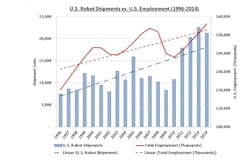If there is a statement I’ve heard more than “automation and robots are taking away all the good manufacturing jobs,” I can't honestly think of it. Most people have heard statements like this so often—and seen at least some evidence of it—that they instinctively feel it to be true. And though no one would dispute that automation and robotics have not eliminated a number of jobs, more data is available to show that advancing technologies are not the sole, or even primary, cause for the big shifts in manufacturing employment over the past few decades.
A new white paper from the Association for Advancing Automation hopes to change people’s minds about the detrimental effects robots have supposedly had on the American manufacturing workforce. Of course, if you’re steadfastly inclined to believe that automation technologies are a principal cause for American manufacturing job losses, you're not likely to believe anything that a group called the Association for Advancing Automation has to say on the matter. But it’s worth taking a look at the evidence.
One of the data points the association offers are statistics that show, from 1996 to 2000, American employment increased while the number of robots being installed grew. And, since 2010, as the U.S. robotics industry set new records for shipments, U.S. employment continued to increase. The association says this indicates that the “use of robots parallels overall improvements in employment.”
Beyond comparing job statistics and robot industry growth, the association’s white paper points out that three key trends have had an effect on how robotics are shaping the U.S. manufacturing industry without negatively impacting jobs: 1) the reversal of offshoring; 2) the use of automation for repetitive and dangerous tasks; and 3) the domestic shift to a service economy. I recommend downloading the free white paper to review all the details.
One of the key highlights of the white paper for me were the number of real world references offered as evidence that it’s no longer (if it ever was) a clear cut choice of hiring a few workers versus buying a robot. Though numerous manufacturing industry references are provided to make this case, it is still nothing more than anecdotal evidence when considered at the macro level. The references, however, are compelling nonetheless. Here are few of my favorites:
- Drew Greenblatt, CEO and owner of Marlin Steel in Baltimore, Md., said, “Not only has changing over to an automated production process saved our company from the threat of bankruptcy—saving the jobs of everyone here—it has allowed us to expand our work force. Since going automated, Marlin Steel has nearly doubled the size of the work force, adding engineers and automated production specialists to our existing team.”
- Hal Blenkhorn, director of engineering at Tegra Medical, a medical device manufacturer, in Franklin, Mass., said: The company doubled its manufacturing throughput and freed 11 full-time manufacturing positions when the company implemented robotics. Tegra was able to repurpose all of these operators into other processes and operations to keep up with company growth. “When we see an operator that does nothing but load a part every 10 or 20 seconds, we try to put more value-add to them by training them in new skills, whether it’s a different operation or by having them become the robot supervisor in that area.” Note: I recently covered Tegra Medical’s incorporation of Universal Robots’ collaborative robotics in the article: Collaborative Robots Help Double Output.
- Jean Piuze, director of operations at Etalex, a shelving system manufacturer in Quebec, Canada, said that the company has limited options for improving profits since the steel for its metal racks makes up 60 percent of the company’s costs. The only option to stay competitive was to optimize production with robotics. As a result, “we’ve had a 40 percent increase in sales which also means that we did not need to lay people off because of automation,” she says. “They have now been freed up to perform more challenging tasks than simple pick-and-place routines.”
- Missy Rogers, president of Noble Plastics in Grand Coteau, La., put it most bluntly by pointing out a company buzz phrase: “Exploit technology not people.” She said, “Low-cost labor exploits people. An efficient manufacturer exploits technology, and that’s what we do.”
It’s not difficult to look back through history and see example after example of advancing technology changing or eliminating some jobs—and even entire industries. But what are the options, really? Pretend these technologies don’t exist while competitors adopt them?
Though it can be painful and difficult to live during these technology inflection points, people—as a whole—do adapt. And it’s important to remember that the introduction of automation into manufacturing is not a zero sum game for employees. As Shan Smith, faculty member at TriCounty Technical College in Pendleton, S.C., once told me, the shift toward greater use of automation in industry has created a large market for people capable of installing, maintaining and operating these technologies. And that market—which has been in dire need of qualified workers for years now—only keeps growing.

